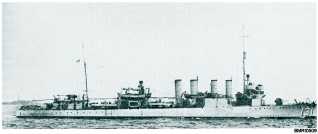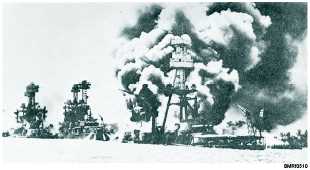Those carriers played an important role in the
prewar years. They were used in exercises to test the
possibility of launching air attacks from their decks.
During fleet maneuvers, naval aviators received
excellent training in mock attacks on Pearl Harbor.
Flying predawn missions from carriers, flyers
theoretically destroyed the U.S. Fleet and its aircraft
there. Fleet commanders were impressed by the
flexibility of the air arm, but no one else seemed to pay
much attention to the exercises.
Destroyers
Between the two world wars, the United States built
the Navy’s destroyer fleet to 184 ships. Destroyers also
became prime factors in America’s policy to turn over
older destroyers (fig. 5-9) to Britain after the British
entered the war against Germany. When the Japanese
attacked Pearl Harbor, a destroyer, USS Ward (DD 139),
was among the first American forces to fire against the
enemy, sinking a Japanese midget submarine.
Destroyers went on to distinguish themselves in
fighting enemy submarines both in the Atlantic and
Pacific theaters.
WORLD WAR II
On the morning of December 7, 1941, the “Rising
Sun” came out of the west when the Japanese pounced
on Pearl Harbor. On that morning, over 15 U.S. Navy
ships were sunk or damaged, including all 8 battleships
of the Pacific Fleet (fig. 5-10). Some 3,400 Navy and
Marine Corps personnel were killed or wounded. The
United States declared war on Japan the next day.
Pacific Arena
The Japanese attack on Pearl Harbor was the first
attack in history conducted solely from aircraft carriers.
The attack proved beyond a doubt that aircraft had
become an essential part of naval armament.
Fortunately, no United States carriers were lost during
the attack on Pearl Harbor. The USS Yorktown, USS
Wasp, and USS Ranger were in the Atlantic, and the
USS Saratoga was in San Diego. The USS Lexington
was about 425 miles south of Midway, and the USS
Enterprise was 200 miles west of the Pearl Harbor.
The Japanese Imperial Navy captured island after
island in the South Pacific as it advanced toward
Australia. The U.S. Navy’s air arm finally stopped that
advance in early May 1942, which set the scene for the
turning point of the war in the Pacific.
At the Battle of Coral Sea, the two fleets never saw
each other—the battle was fought entirely with aircraft
launched from carriers. The USS Lexington and USS
Yorktown, jointly under the command of Admiral F. J.
Fletcher, launched 93 attack planes against the Japanese
carriers Shoho, Shokaku, and Zuikaku. Within
5 minutes, the Shoho was hit with 10 heavy bombs and
15 torpedoes. The USS Lexington’s radio crackled with
the voice of Lieutenant Commander Dixon of the air
group, “Scratch one flattop. Dixon to carrier, scratch
one flattop!” The other two enemy carriers were so
badly damaged that their services to the Japanese fleet
were lost for weeks. The United States suffered the loss
of an oiler, an escort, and the USS Lexington. Even
though American losses were heavy in tonnage and
men, Australia had been saved from invasion.
5-16
Student Notes:
Figure 5-9.—Destroyer built shortly after World War I.
Figure 5-10.—The day of infamy.





